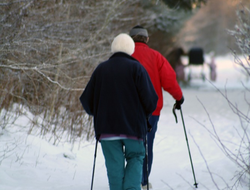Physical activity and aging: Stay younger longer.
Published: August 25, 2022
As children and young adults we can’t wait to “grow up”.
As we age we want to turn the clocks back or at least stem the tide of the aging process and assumed physical and mental decline.
Frequently research reports highlight the benefits of regular physical activity in relation to health and wellbeing for people of all ages.
However, fewer than 5% of North Americans meet recommendations for physical activity or other lifestyle behaviours.
Only a very small proportion of adults, and an even smaller proportion of older adults, achieve the recommended 150 minutes per week of moderate to vigorous intensity aerobic physical activity.
Time, cost, accessibility, relationships, perceived ability, motivation, and leisure activity preferences are all reasons why people aren’t physically active on a regular basis.
However, physical activity benefits people throughout their life span.
Research consistently reports that rather than giving up on physical activity and exercise as we age, we should be making the effort to “keep on going” to preserve our health and independence.
The belief that too much or too vigorous exercise will wear us out and use up all our energy is not supported by current research.
Quite the opposite, regular physical activity can slow the aging process and help maintain health and quality of life.
Conversely, a sedentary lifestyle will promote the aging process with associated declines in physical and mental health.
We tend to assume that diseases that occur with aging are a natural part of the aging process.
However, many of the physical limitations that occur are associated with physical inactivity and not with the aging process.
It is never too late to begin a physical activity program.
Research shows that people in their eighth decade can improve cardiovascular fitness, strength and endurance and flexibility.
Adopting a physically active lifestyle throughout your lifespan by incorporating physical activity into your everyday routine can help slow the aging process both physically and mentally.
This article discusses the science which underpins the connection between regular physical activity and a slower aging process...follow the link to the full article.
Related Topics
Health Physical Capabilities Physical Activity Exercise Muscles Cardiovascular Fitness Your BodyReferences
2.
Whitney, E. & Rady Rolfes, S. (2005). Understanding Nutrition. Belmont, CA: Thomson Wadsworth
3.
Centre for Science in the Public Interest (August, 2011). Nutrition Action Health Letter (April, 2011)
4.
Chakravarty et al. (2008). Reduced disability and mortality among aging runners. Arch. Intern Med. 168 (15): 1638-1646
5.
Cherkas et al. (2008). The association between Physical Activity in leisure time and leukocyte telomere length. Arch. Intern. Med. 168 (2) 154-158
6.
Dumurgier, et al. (2009). Slow walking speed and cardiovascular death in well functioning older adults: prospective cohort study. BMJ 2009; 339 doi: http://dx.doi.org/10.1136/bmj.b4460


